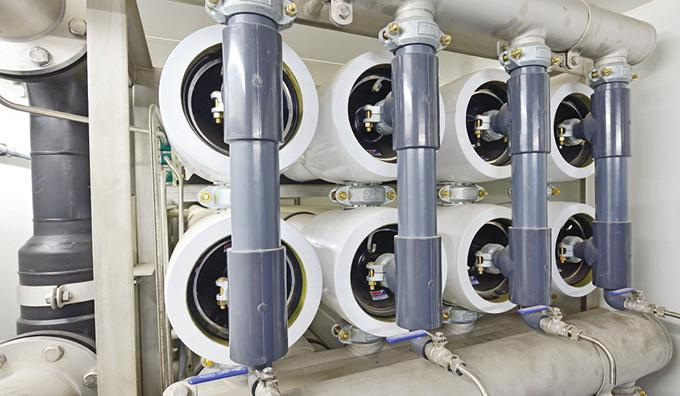Innovation Leads The Way To Solving Desalination Challenges
By Richard L. Stover, Member of the International Desalination Association (IDA) Board of Directors
IDA is the world’s leading organization focused on desalination and advanced water treatment including water reuse. It is associated with the United Nations as part of a growing international network of nongovernmental organizations (NGOs), with membership that includes end users, solutions providers, and technology developers; engineers, consultants, scientists, and researchers from governments, corporations, and academia; as well as financial institutions and providers of other services to the desalination and water reuse industry. For more information, visit www.idadesal.org.
Not just a solution for water-scarce cities by the sea, desalination is also vitally important for industrial processes and many inland utilities reliant on groundwater. Like other treatment technologies, continued water security and prosperity depend on improvements in the processes and developments on the horizon.
The birth and growth of the desalination industry have always depended on technological advances to overcome physical and economic challenges. In the 1990s and 2000s, for example, innovation focused on reducing energy consumption in seawater desalination. Several breakthrough advancements resulted from this work, including improved reverse osmosis (RO) membrane performance and reliability and the innovation of energy recovery devices. Not only was the energy required for seawater desalination cut in half, but very large membrane desalination plants also became possible.
Thanks to the terrific work that was done by many companies, researchers, and innovators, today’s RO plants operate at about the lowest energy consumption that's reasonable to achieve, and its adoption has been widespread. Desalination is now practiced in 150 countries and, globally, more than 300 million people rely on desalinated water for some or all of their daily water needs.
Still Evolving
Today, RO remains the dominant technology for desalination, but innovation is now aimed at achieving different objectives — in particular, raising freshwater yield, reducing waste brine production, and dealing with tougher water sources. Desalination is increasingly moving away from the sea as innovation spurs the growth of desalination in industrial and inland brackish applications.
Brackish water is defined as being less salty than seawater. It might come out of the ground or it might be a waste stream. The reason that high freshwater recovery and brine minimization are so key in brackish desalination is that the cost and environmental issues associated with disposing of brine can be substantial. In fact, brine disposal or treatment is the largest cost component of brackish and industrial water desalination. This is where we see a lot of R&D and innovation currently taking place, and we expect that to continue in the next 10 years.
Here are five exciting developments that hold great promise in achieving higher recovery and minimizing brine production:
- The first development is getting higher freshwater recovery out of RO. One group of methods being used and improved upon includes process designs that feature transient or batch operations. They involve recirculation of the brine back to the membrane feed for a period of time, followed by a flushing step. Recirculation increases the recovery rate by increasing freshwater yield and reducing brine flow. This is how many microfiltration systems work, but, historically, batch operation has not been applied to reverse osmosis. Recent results have been promising, with reported brackish RO recovery rate increases from the historical standard of 75 percent to as high as 98 percent.
High-pressure membranes are another means of increasing RO yield and reducing brine production. Although even high-pressure membranes are limited to 1,200 to 1,800 psi, while the pressure required to concentrate brines to higher than 10 percent salt with RO can be many thousands of psi, any increases in RO recovery reduce the cost of downstream brine treatment or disposal.
-
The second area of innovation is in an earlier stage of development, but shows promise for higher brine concentrations without exceedingly high feed pressures. Counter-flow RO, or osmotically assisted RO, incorporates a saline solution on the freshwater side of the membrane to reduce desalination’s osmotic pressure barrier. This innovation reduces feed pressures enough to allow use of standard RO membranes and equipment for treating brine streams up to 25 percent salt. Historically, brine concentration to greater than 7 percent salt required use of an evaporator — a very energy- and cost-intensive desalination method. The production of 25 percent salt brines with RO represents more than a threefold reduction in brine production and a dramatic increase in the range of usability of RO, as well as an increase in freshwater yield.
-
The third innovation is for desalination applications where thermal methods are required — for example, oil and gas wastewater that contains concentrations of organic materials that would quickly foul RO membranes. One of the most promising is humidification/dehumidification. This process bubbles a carrier gas through the brine to evaporate water out of it in the same way that air moves water around in nature. Evaporation is followed by rain-like condensation, producing very pure product water and leaving behind brine concentrations of 25 percent or more.
-
The fourth promising innovation is the integration of precipitation and clarification with desalination. At high brine concentrations, some salts tend to come out of the solution and deposit on equipment surfaces, stopping or slowing the desalination process. Salt deposited in this way is called scaling. One way to address this problem is to deliberately precipitate and remove these salts before desalination or as an interim step, thereby allowing additional desalination. There's a lot of work going on in the integration of precipitation into both membrane and thermal desalination processes, and we expect to see continued innovation in this arena.
-
The fifth innovation is improved membranes. Researchers are attempting to make membrane materials that can be operated at extremely high pressures, at extremely high salinities, or under conditions that would foul or scale today's membranes. This includes not only new membrane materials, but also the ways in which the membranes are put together and operated. Better membranes could enable increased recovery and reduced brine production while further reducing energy consumption.

Reverse osmosis equipment
There are two other innovations that warrant mention when discussing advances in desalination.
One is the development and incorporation of digital technology. Smarter systems that better detect, anticipate, and manage desalination upsets and operations are an ongoing opportunity and challenge that many are working on. Day-to-day operations and new innovations alike are potentially informed and enhanced by improvements in process control, monitoring, and response. For example, an instrument that could detect an increased risk of scaling before it actually happens could enable operators to reduce system shutdowns and cleaning requirements.
Second, new business models may encourage earlier adoption of new technologies. The design-bid-build project structures still used in many municipal and industrial sectors select system designs largely on the basis of lowest capital cost, which inherently favors incumbent technologies. Although many new technologies can provide better long-term value, they are often shut out by old business models. Conversely, most large seawater desalination plants around the world are awarded as design-build or design-build- operate contracts bid on a long-term cost-of-water basis. With this criterion, large seawater desalination projects have incorporated innovations to the benefit of everybody involved. As this model is increasingly adopted across industrial and municipal sectors, we may well expect to see more rapid uptake of innovation.
Ongoing innovations in desalination technology go beyond creating new opportunities for water equipment and service providers. These advancements can have a profoundly beneficial impact on global water resources by making desalination more sustainable and affordable, a goal that the International Desalination Association (IDA) supports and promotes around the world.
About The Author
 Richard L. Stover, Ph.D., has 25 years of experience making global water resources sustainable through improved treatment efficiency. As president of Gradiant Membrane Systems, he is enabling inland desalination and water reuse projects that were not previously possible without a new membrane brine concentration process. In his previous role as Desalitech’s executive vice president, he was responsible for growth of the company’s reverse osmosis products. He previously served as chief technical officer and senior vice president of marketing for Energy Recovery, Inc., the leading supplier of energy recovery devices for seawater desalination.
Richard L. Stover, Ph.D., has 25 years of experience making global water resources sustainable through improved treatment efficiency. As president of Gradiant Membrane Systems, he is enabling inland desalination and water reuse projects that were not previously possible without a new membrane brine concentration process. In his previous role as Desalitech’s executive vice president, he was responsible for growth of the company’s reverse osmosis products. He previously served as chief technical officer and senior vice president of marketing for Energy Recovery, Inc., the leading supplier of energy recovery devices for seawater desalination.
Dr. Stover has been granted numerous patents. He was corecipient of the European Desalination Society’s Sidney Loeb award for outstanding innovation. He has a Ph.D. from the University of California, Berkeley, and a Bachelor of Science degree from the University of Texas, Austin, both in chemical engineering. Dr. Stover serves on the board of the International Desalination Association
